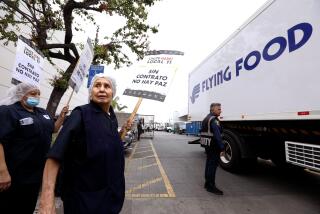Workers Fear Douglas List of ‘Expendables’ Means Layoffs
- Share via
LONG BEACH — The trouble began on Nov. 17, when union members at Douglas Aircraft got hold of an official, yet unsigned letter that designated 27 of their fellow workers as “(Department) 509 Expendables.”
Among those listed was Steve Hovermale, an 8-year structural mechanic who reacted as most anyone might: his stomach gradually tightened as he feared he was about to be fired.
“(Co-workers) were saying, ‘Hey, we heard you’re expendable,”’ said Hovermale, a member of the United Auto Workers, Local 148. “It was humiliating.”
Within hours, a furor had spread throughout the 550-employee department, where an airliner known as the MD-80 is assembled. Company officials and union leaders have been scurrying ever since to dispel any notion that layoffs are imminent.
“(Expendable) was a bad word,” admitted Douglas spokesman Dave Eastman, who acknowledged that the list was compiled by company officials. He said, however, that no one in management is sure which officials are responsible. “It was mislabeled ‘expendable.’ It conveyed something what was not intended.”
At one point the fear of a layoff became so pervasive, Eastman said, that company officials visited the department floor to apologize for any misunderstanding and personally promise workers that no one was considered expendable.
List Described as Tool
The list, Eastman said, was merely a tool to help shop leaders identify which workers should be offered remedial training to sharpen their skills.
In the meantime, the debate over the list has rekindled a long-running controversy within the 14,000-member local union over what direction it should be taking in labor-management relations.
Although some members of the aircraft company’s largest local insist that the list was prepared to single out certain workers, most union leaders accept the company’s explanation.
Union President Douglas Griffith agreed that the list merely outlined which workers were in line for on-the-job training.
Griffith narrowly won a bitter union election in September, 1987, on a pledge to develop “mutual trust and respect” with company officials. The victory ended a year of strife between two union factions, all of which had been compounded by protracted contract negotiations with Douglas.
The previous president, Bob Berghoff, had been ousted by the United Auto Worker’s international local the summer before amid allegations of ballot tampering in a May election against Griffith. Berghoff had orchestrated a 17-week strike in 1983 and 1984 that failed to win any contract concessions, and he was suspended from his job last year for calling a one-day walkout to protest the loss of his union post.
“We don’t know where it (the ‘expendables’ list) came from,” Griffith said recently. “But one thing we know: There are no expendable people in the union.”
Some lower-level union officials and a number of rank-and-file members say, however, that they believe the list is a sign that a limited layoff was planned.
“It was a hit list, that’s what it was,” said shop steward Wilbert Sonnier, who obtained the initial copy of the letter from a source in the company’s labor relations department. “These guys were told that (management) wanted to weed out all the dead weight.”
Filed Grievances
Sonnier, who filed grievances two weeks ago on behalf of each employee named in the letter, contends that the list is further proof that a new union experiment, known as the Employee Involvement Program, is not adequately protecting the jobs of Local 148 members.
The pilot program, initiated over the summer, involves the appointment of so-called “facilitators” who oversee the job performance of union workers. The program is intended to give the union more control over its own work force, union officials say.
But Sonnier says the program is being increasingly criticized by the rank and file because it pits union workers against each other. The ‘expendables’ list, he says, could not have been compiled without the help of facilitators, who are union members.
“The company wanted the (Employment Involvement) Program,” Sonnier said. “What they wanted to do is weaken the union and get everybody fighting. It erodes the union and gets rid of our solidarity.”
In response, Griffith charged last week that Sonnier is deliberately attempting to rekindle year-old animosities within. He accused Sonnier of being “anti-union” and undermining the union’s new “cooperative approach” to labor-management relations.
‘Making Problems’
“That man is deliberately running around making problems,” Griffith said. “The relationship we’ve been fostering (with Douglas) is based on mutual respect and trust.”
Sonnier defends his actions as not being motivated by any loyalty to former union leader Berghoff. He said that Griffith “can call me what he wants” for filing the grievances and openly criticizing the new union program.
“I am just doing my job,” Sonnier said. “I don’t see how protecting my people can be construed as being a troublemaker.”
More to Read
Sign up for Essential California
The most important California stories and recommendations in your inbox every morning.
You may occasionally receive promotional content from the Los Angeles Times.









